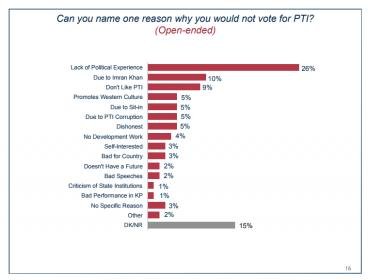hussain.r97
ODI Debutant
- Joined
- Apr 30, 2013
- Runs
- 11,153
Full report here - https://drive.google.com/file/d/0B9UPGfeIDN8YcWFjbWZsV1BveW8/view
It seems like the methodology for this poll was sound, they also split based on demographics correctly.
According to the survey, the voter intentions in Pakistan are as below:
If the national assembly election were held next week for which party would you vote for? (Open-ended)
If the national assembly election were held next week for which party would you vote?
(Party Vote by Province) (Open-ended)
Great to see PTI with a clear majority in KPK. An interesting thing to note is JUI-F is almost dead according to this survey.
PTI interestingly high in Balochistan, could it be due to the Pashtun population in the north voting the same way as the Pashtuns of KPK?
There are also some more really interesting questions in the link I gave above. One that stood out was -
It's too bad that there is no regular polling in Pakistan. If there was, we could see some actual trends emerging, and maybe have a better idea. However, this poll doesn't seem to be anything too unexpected, and it looks quite promising.
The methodology is quite sound too.
• Voters are split on whether or not the country is headed in the right or wrong direction. While they generally felt good about security, law and order, and development, they expressed concern about the economy, load shedding, and corruption.
• The survey also showed that Pakistanis were angry about the Panama Papers scandal, supported the Supreme Court verdict, and supported the resignation of former prime minister Nawaz Sharif.
• PML-N maintains a lead in the ballot test at 38 percent, with PTI in a very strong second place at 27 percent. PPP is in third with 17 percent.
• Overall the PML-N federal government had a strong job approval rating at 58 percent. The new Prime Minister Shahid Khaqan Abassi received somewhat lower marks, with 43 percent saying that they approved of the job he was doing.
• The survey also tested some of the names of potential successors to Nawaz Sharif that have been mentioned in the press. Current Punjab Chief Minister Shahbaz Sharif has emerged as the best choice of the potential PML-N candidates.
It seems like the methodology for this poll was sound, they also split based on demographics correctly.
According to the survey, the voter intentions in Pakistan are as below:
If the national assembly election were held next week for which party would you vote for? (Open-ended)
PML-N: 38%
PTI: 27%
PPP: 17%
MQM-P: 3%
JUI-F: 1%
ANP: 1%
JI: 1%
BNP: 1%
PML-Q: 1%
Other: 4%
No Response: 7%
If the national assembly election were held next week for which party would you vote?
(Party Vote by Province) (Open-ended)
Punjab-
PML-N - 58%; PTI - 23%; PPP - 6%; JI - 1%; PML-Q - 0%; IND - 1%
KPK -
PTI - 62%; PML-N - 10%; ANP - 5%; JI - 1%; JUI-F - 1%; PPP - 2%
Great to see PTI with a clear majority in KPK. An interesting thing to note is JUI-F is almost dead according to this survey.
Sindh -
PPP - 52%; PML-N - 12%; MQM-P - 11%; PTI - 14%; PML-F - 2%; JUI-F - 1%; JI - 1%
Balochistan -
PTI - 33%; PML-N - 15%; PPP - 9%; BNP - 8%; PKMAP - 6%; ANP - 2%; NP - 1%
PTI interestingly high in Balochistan, could it be due to the Pashtun population in the north voting the same way as the Pashtuns of KPK?
There are also some more really interesting questions in the link I gave above. One that stood out was -
Would you ever consider voting for PTI?
Yes, maybe - 37%; No, never - 54%; Don't Know - 9%
It's too bad that there is no regular polling in Pakistan. If there was, we could see some actual trends emerging, and maybe have a better idea. However, this poll doesn't seem to be anything too unexpected, and it looks quite promising.
The methodology is quite sound too.
• Data was collected by the IPOR Consulting under the supervision of Global Strategic Partners (GSP).
• The sample consisted of 4,540 interviews and has a confidence interval of ±1.5% at the mid-range with a confidence level of 95%. The response rate was 71%.
• The sample was distributed in 73 Districts of all four provinces of Pakistan (except the Federally Administered Tribal Areas and Chitral). The survey is a nationally representative sample of voting-age residents of Pakistan, age 18 and above. The data collection concluded in September 2017. The interviews were all in-person and in-home.
• A multi-stage probability sample was used. In the first stage, the sample was stratified into four provinces. In the second stage, the sample was further stratified into districts within each province and divided into rural and urban categories. In the third stage, each district was further stratified by union councils.
• Interview teams were comprised of both males and females; the female respondents were interviewed by female interviewers and male respondents by male interviewers.
• The Probability-Proportional-to-Size (PPS) method was used to select localities and household were selected through “Random Walk Method”. After a random starting point was selected, the Left Hand Rule (LHR) was used and then a skip pattern where every nth household were selected for interviews. The Kish Grid was used to select respondents 18 years and older within these randomly selected
households.
• The information in this report has been compiled in accordance with international standards for market and social research methodologies. Figures in charts and tables may not sum to 100 percent due to rounding error.











.png)

